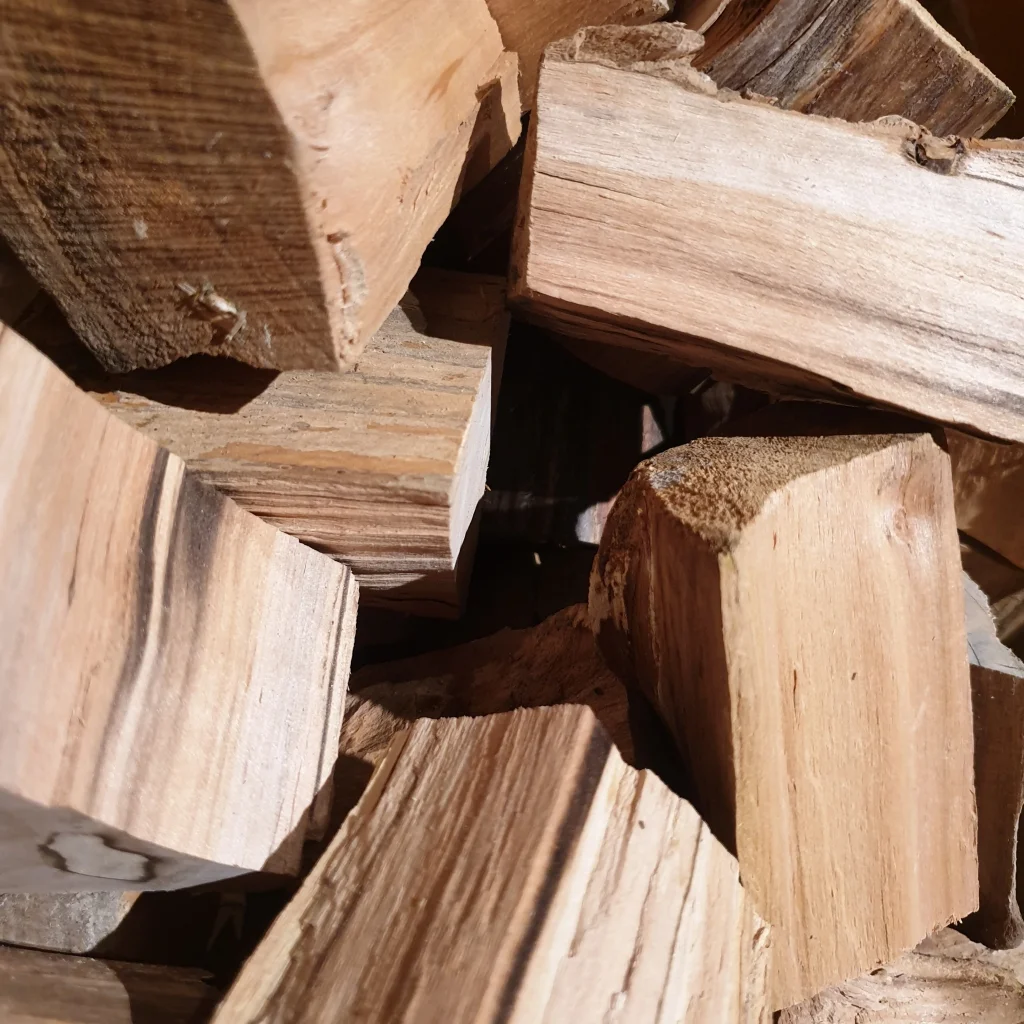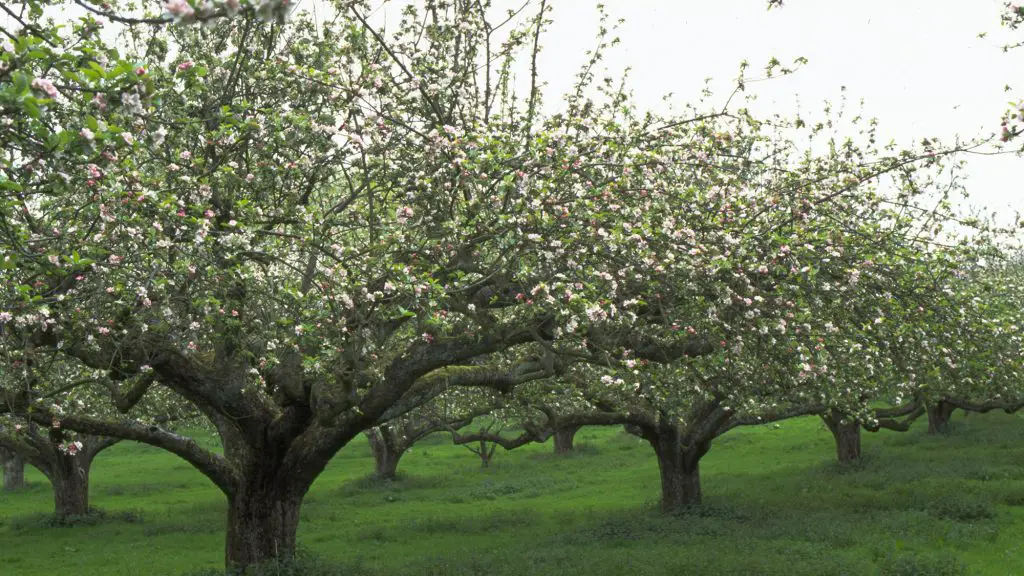Apple firewood is excellent for smoking heat and heating your home during winter, but it is challenging to stockpile enough due to its low availability. It is a slow-burning, long-lasting hardwood with high heat production, similar to oak. Its smoke has a great, sweet smell, but it is moderately difficult to split.
Unfortunately, apple is only available around commercial farming operations because it is not native to North America. You will need to pay a high price or know the right person to get yourself enough apple wood to do anything more than smoke the occasion meat.
Table of Contents
Summary
- BTU: 27 million BTU/cord
- Weight: 4850 lb/cord green
- Seasoning Time: 12-24 months
- Splitting Difficulty: Medium
- Sap Content: Low
- Smoke: Low
- Smell: Sweet, Strong, Pleasant
Overall, Apple is excellent as firewood and is one of the very best options you can pick. The heat production is extremely high, on par with oak, and the combination of low smoke and low sap makes it ideal for indoor heating. I have heard people claim they can smell apple fruit in the smoke, but I can’t myself – it smells sweet and pleasant to me.
However, the main disadvantage is the difficulty in splitting. This is a dense hardwood that requires some elbow grease to cut through. You will want to get a long-handled splitting axe or maul if you are splitting a few pieces every day or a log splitter if you are preparing your entire stockpile all at once.

Heat Production
Apple firewood has one of the best heat productions of any hardwood. It is very similar to oak and black locust with a BTU of 25+ per cord. The wood burns slowly for long periods and leaves coals that are ideal for cooking. It can be difficult to light, and I suggest using some easier-to-light softwood kindling to get the fire going.
One of the disadvantages is the size of the tree. The logs you can hew from a tree are significantly smaller than the mighty oak. This means you won’t get those large logs that will burn all night. You will need to be continuously adding more smaller apple firewood logs to the fire.
Smoke Production
The smoke generation from apple firewood is low, especially if it is correctly seasoned. I always suggest avoiding burning green firewood whenever possible because of the extra moisture and sap in the wood.
Apple has a great smell that doesn’t get overpowered by an excessive amount of smoke. This is why it is ideal for smoking meats but also suitable for burning indoors.
Seasoning Time
Apple firewood takes between 12 and 24 months to season, depending on your location and weather conditions. If you have kept the wood in rounds, it can take even longer, up to 3 years, so I strongly recommend splitting it early.
Hardwood that takes a long time to harvest requires optimal stacking techniques to reduce that time as much as possible. Stack the firewood in rows with airflow in between. Cover the top of the stockpile with a tarp to prevent rain from wetting the wood but leave the sides open for sunshine and airflow.
You will need to plan your firewood at least a year in advance if you are using hardwoods like apple, so you might consider adding some softwood to top it up if you think you haven’t prepared enough in advance.
I personally recommend this General Tools Moisture Meter. It allows you to accurately gauge how wet your firewood is and whether it is sufficiently seasoned. Over time you can also see how quickly the moisture is dropping and how much longer you need to keep your firewood dropping until it is seasoned and ready to burn.
Press the sharp pins into the wood and you will quickly see the readout show the moisture ranging from 5% to 50%. It also has a Low/Mid/High indication depending on whether the wood is dry enough, so you don’t need to remember the actual values.

Burning Smell
Apple is one of my favorite smelling firewood (just behind Hickory). Some people claim they can smell apple fruit, but I can’t. I smell a pleasant, sweet, strong scent that I enjoy. This is one of the reasons I prefer using apple for my indoor heating, as long as I can get enough of it.
It is also a favorite for smoking meat as you can get that same flavor into the food. Apple wood smoked bacon is a popular option.
Creosote Buildup
Creosote is a black soot substance that builds up from unburnt wood and can block your chimney. Other times this can create chimney fires, so you must clean your chimney annually. Creosote builds up more quickly in softwood and unseasoned firewood.
Apple is a hardwood, and as long as it is seasoned correctly, you will not have any problems with creosote building up. This is a reminder not to burn the wood early. I still recommend cleaning your chimney frequently, even when burning hardwood exclusively to eliminate this risk completely.
Splitting
Apple wood is moderately difficult to split, but because of the high heat production, you may not need to stockpile as much lumber as other options. To reduce the seasoning time, I recommend storing your wood as split logs rather than rounds, so you should start splitting as soon as you have it available.
The apple logs are also much smaller than giant trees, so although it is moderately challenging to split, the diameter of the individual logs is lower than something like oak.
Having said that, if you get access to multiple apple trees to process, I suggest getting a log splitter.
Different Types/Species
There are over 7,500 species of Apples as they have been bred commercially for different fruit properties.
Apples are not native to the United States, so you will generally only find apple wood available as a byproduct of fruit orchards. Apple trees thrive in areas that have cold winters, with the top producing states being Washington, New York, and Michigan.
Apple trees don’t grow particularly large like an oak, so you will never get large logs that will burn all night. If you are felling a dead apple tree, you will only get a few decent-sized logs and a lot of branches. The yield of firewood per tree is low.
The most common species of apple tree are (you will recognize these from the grocery store):
- Honeycrisp
- Fuji
- Granny Smith
- Red Delicious
- Golden Delicious
- McIntosh
- Gala
- Pink Lady
- Empire
- Rome
- Cripps

Comparison to Other Woods
Here, I’ve taken some of the most popular firewoods to burn indoors and compared them to Apple firewood. Apple firewood is one of the best hardwoods you can get – it has a high heat production, makes good coals, low smoke generation, and is moderately hard to split.
The main disadvantage of apple wood is its availability. Apple trees are generally only found around orchards and are only cut down when they have died naturally or are being removed for commercial reasons.
| Firewood | Million BTU/Cord (source) | Ease of Splitting | Coals | Overall Quality |
| Green Ash | 20 | Easy | Good | Excellent |
| Maple | 25 | Easy | Excellent | Excellent |
| Bur Oak | 26 | Easy | Good | Excellent |
| Apple | 27 | Moderate | Good | Excellent |
Apple is one of my favorite firewood. I love throwing a piece onto my campfire and enjoying the pleasant smoke smell without being overpowered by it. I would be happy to heat my home with apple wood all winter. However, it is unlikely I will ever have a stockpile completely full of it. A more likely scenario is that I get a single dead tree to add to the rest of the stocks of other hardwood species.
FAQs
Can you burn Apple wood in a fire pit?
Yes, apple firewood is ideally suited for burning in a fire pit. Its combination of high heat production and good coals means you can use it for heating and cooking. Apple is renowned for smoking meat because of the flavor and scent of its smoke. It burns for long periods, similar to other hardwoods.
Can you burn Apple wood in a wood stove?
Yes, apple firewood can be used indoors. It has a pleasant smell from its low smoke generation that is ideal for burning inside. I recommend stockpiling apple wood to heat your home all winter, as long as you can get your hands on enough. It is also unavailable in as large logs as other hardwoods, so you must continually add smaller logs to your fire.
How much does Apple firewood cost to buy?
Apple firewood is excellent quality and costs similar amounts to other hardwood species at between $200 and $400 per cord. Apple wood is challenging to find because it is primarily grown for commercial fruit production and is not native to the US.
Final Thoughts
Apple firewood is one of my favorites because of its high heat production and pleasant smell. It is in high demand for smoking meat but can be difficult to find in large quantities. A single apple tree only grows to around 15 feet, and a lot of that wood is spindly branches, so the wood yield per tree is low. If you happen to get access to some apple wood, I strongly recommend adding it to your stockpile, but you may not be able to rely on it for all your firewood needs.
